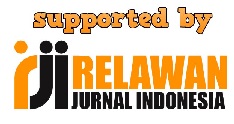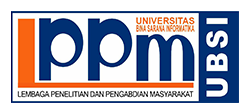STRATEGI PENGEMBANGAN SMA MENGGUNAKAN ANALISIS SWOT: STUDI KASUS SMA NRD, JAKARTA, INDONESIA.
Abstract
Penelitian ini bertujuan untuk merumuskan strategi yang tepat bagi sekolah menengah atas (SMA) NRD di era persaingan yang sangat ketat antar sekolah. Perumusan strategi dilakukan dengan menggunakan SWOT sebagai alat analisis. Ada tiga tahap yang dilakukan pada analisis SWOT yakni; tahap input, tahap pencocokan dan tahap pengambilan keputusan. Penelitian ini menggunkan analisis deskriptif dengan metode kualitatif dan kuantitatif dimana narasumber dan responden sebanyak sebelas orang yang terdiri dari satu kepala sekolah, satu wakil kepala sekolah bidang kurikulum, satu kepala sekolah bidang kesiswaan dan delapan guru mata pelajaran. Teknik pengumpulan data yang digunakan adalah focus group discusson (FGD) dan kuesioner. Pada tahap input, data diolah dengan menggunakan dua matriks yakni; matriks EFAS (External Factor Analysis Strategy) dan IFAS (Internal Factor Analysis Strategy), lalu pada tahap pencocokan digunakan dua matriks yang terdiri dari matriks TOWS dan IE (Internal External) sedangkan pada tahap pengambilan keputusan menggunakan QSPM (Quantitative Strategic Planning Matrix). Hasil penelitian menunjukkan bahwa strategi yang tepat bagi sekolah menengah atas NRD adalah melakukan pengembangan produk dengan cara meningkatkan kualitas guru, kurikulum dan fasilitas sekolah.
Kata Kunci : Manajemen Stratejik, Analisis SWOT, EFAS & IFAS, IE & TWOS, QSPM.
Keywords
Full Text:
PDF (Bahasa Indonesia)References
Abdi, A., Ashouri, M., Jamalpour, G., & Sandoosi, S. M. (2013). Overview SWOT Analysis Method and Its Application in Organizations. Singaporean Journal of Business Economics, and Management Studies, 69-74.
Aziz, F., & Akhtar, M. M. (2014). Impact of Training on Teachers' Competencies at Higher Education Level in Pakistan. Journal of Arts, Science & Commerce, 121-128.
Basset, M. A., Mohamed, M., Sangaiah, A. K., & Jain, V. (2018). An integrated neutrosophic AHP and SWOT method for strategic planning methodology selection. Benchmarking: An International Journal.
Buyukozkan, G., & Ihcak, O. (2018). Integrated SWOT analysis with multiple preference relations Selection of strategic factors for social media. Kybernetes, 1-20.
Chaudhary, G. K. (2015). Factors Affecting Curriculum Implementation for Students. International Journal of Applied Research, 984-986.
Cojocariu, V.-M., Lazar, I., Nedeff, V., & Lazar, G. (2013). SWOT Analysis of e-learning educational services from the perspective of their beneficiaries. 5th World Conference on Educational Sciences - WCES 2013 (pp. 1999-2003). Romania: University of Bacau.
David, F. R., & David, F. R. (2015). Strategic Management Concepts and Cases. Harlow: Pearson.
Dunlosky, J., Rawson, K. A., Marsh, E. J., Nathan, M. J., & Willingham, D. T. (2013). Improving Students' Learning With Effective Learning Techniques: Promosing Directions From Cognitive and Educational Psychology. Psycological Science in the Public Interest, 4-58.
Dyson, R. G. (2002). Strategic Development and SWOT analysis at the University of Warwick. Europen Journal of Operational Research, 631-640.
Gupta, G., & Mishra, R. P. (2016). A SWOT analysis of reliability centered maintenance framework. Journal of Quality in Maintenance Engineering, 130-145.
Hamid, S. R., Hassan, S. S., & Ismail, N. A. (2012). Teaching Quality and Performance Among Experienced Teachers in Malaysia. Australian Journal of Teacher Education, 85-103.
Harris, S. Y. (2018). SWOT analysis of Jamaican academic libraries in higher education. Library Management, 246-278.
Helms, M. M. (2011). Entrepreneurial potential in Argentina: a SWOT analysis. Competitiveness Review: An International Business Journal, 269-287.
Ibrahim, W. Y., Umar, H. A., & Clement, I. (2017). Impact of School Facilities on Students' Academic Achievement. International Journal of Advanced Research, 878-889.
Ilomo, O. (2016). The Availability of Teaching and Learning Facilities and Their Effects on Academic Performance in Ward Secondary Schools in Muheza-Tanzania. International Journal of Education and Research, 571-582.
Kamrozzaman, N. A., Badusah, J., Muna, W., & Mohammad, R. W. (2018). Coggle: SWOT Analysis in Lifelong Learning Education Using Online Collaborative Mind-Mapping. International Journal of Academic Research in Business & Social Science, 2195-2206.
Karaskota, C. (2016). Investigating EU-Turkey renewable cooperation opportunities: a SWOT Analysis. International Journal of Energy Sector Management, 337-362.
Kumar, A., Srivastava, A., Kumar, R. J., & Tiwari, R. K. (2018). Analyzing Indian Research and Development Organizations. International Journal of Innovation, 298-315.
Lee, S. F., Lo, K. K., & Sai On Ko, A. (2000). Strategy Formulation Framework for Vocational Education: Integrating SWOT analysis, Balanced Scorecard, QFD Methodology, and MBNQA Education Criteria. Managerial Auditing Journal, 407-423.
Ningtiyas, F. A., & Jailani. (2018). Does Teacher's Training Affect the Pedagogical Competence of Mathematics Teachers? Journal of Physics, 1-8.
Oke, A. E. (2018). SWOT analysis of indigenous and foreign contractors in a developing economy. International Journal of Quality & Reliability Management, 1289-1304.
Ommani, A. R. (2011). Strenghts, Weaknesses, Opportunities and Threats (SWOT) Analysis for Farming System Businesses Management: Case of Wheat Farmers of Shadervan District, Shoushtar Township, Iran. African Journal of Business Management, 9448-9454.
Orafi, S. M. (2013). Effective Factors in the Implementation of ELT Curriculum Innovations. Scientific Research Journal, 14-21.
Selvi, K. (2010). Teachers' Competencies. International Journal of Philosophy of Culture and Axiology, 167-176.
Shojaie, M., Hamidian, M., & Basiji, A. (2014). Strategy Planning Using SWOT analysis and QSPM Model A Case Study of Baridsoft Company. International Journal of Scientific Management and Development, 252-257.
Sumiarsih, N. M., Legono, D., & Kodoatie, R. J. (2018). Strategic Sustainable Management for Water Transmission System: A SWOT-QSPM Analysis. Journal of Civil Engineering Forum, 29-40.
Talib, M. S., & Hamid, A. B. (2013). Halal Logistics in Malaysia: a SWOT analysis. Journal of Islamic Marketing, 322-343.
Wright, E. W., Hillon, Y. C., Lopez, M. G., & Fowler, D. (2018). A new scorecard for strategic planning. Journal of Business Strategy, 1-9.
Zainuddin, A. B., & Subri, F. (2017). The School Facilities towards the Improvement of Students' Academic Achievement: Case Study - Secondary Schools in Klang. Journal of Modern Education Review, 647-653.
DOI: https://doi.org/10.31294/jeco.v4i1.6767
Copyright (c) 2020 William Widjaja

This work is licensed under a Creative Commons Attribution-ShareAlike 4.0 International License.
ISSN: 2355-0295 || E-ISSN: 2549-8932
-----------------------
Indexed by:
dipublikasikan oleh LPPM Universitas Bina Sarana Informatika dengan dukungan Relawan Jurnal Indonesia
Jl. Kramat Raya No.98, Kwitang, Kec. Senen, Kota Jakarta Pusat, DKI Jakarta 10450

This work is licensed under a Creative Commons Attribution-ShareAlike 4.0 International License






